Coupling Effect of Salt Freeze-Thaw Cycles and Carbonation on the Mechanical Performance of Quick Hardening Sulphoaluminate Cement-Based Reactive Powder Concrete with Basalt Fibers
Abstract
:1. Introduction
2. Experimental
2.1. Raw Materials
2.2. Specimen Preparation and Measurement Methods
3. Results and Discussion
3.1. Mechanical Strength
3.2. Mechanical Properties of SAC-RPC during NaCl Freeze-Thaw Cycles
3.3. Mechanical Properties of SAC-RPC during the Coupling Effect of Carbonation and NaCl Freeze-Thaw Cycles
4. Conclusions
- The addition of basalt fibers demonstrated positive effect on the mechanical strengths and the resistance of NaCl freeze-thaw cycles and carbonation. The basalt fibers’ volume of 3% was the threshold value of the mechanical strengths. The enhancing effect of basalt fibers on flexural and bonding strengths was more obvious than that of compressive strength. When the curing age was higher or equal to 5 h, the flexural, compressive and bonding strengths of SAC-RPC were higher than 8.53 MPa, 34 MPa and 3.21 MPa, respectively.
- The mass loss and the mechanical strengths of basalt fibers reinforced SAC-RPC showed an increasing quadratic function with the increasing number of NaCl freeze-thaw cycles. Meanwhile, the loss rate of mechanical strengths and carbonation depth decreased in the form of quadratic function with the volume of basalt fibers.
- The carbonation demonstrated little effect on the mechanical strengths of basalt fibers reinforced SAC-RPC. However, the coupling effect of carbonation and NaCl freeze-thaw cycles could accelerate the attenuation of mechanical properties. The SAC-RPC with basalt fibers showed better resistance to NaCl freeze-thaw cycles than that of steel fibers reinforced SAC-RPC. Furthermore, the mechanical strengths of SAC-RPC with basalt fibers were worse.
Author Contributions
Funding
Institutional Review Board Statement
Informed Consent Statement
Data Availability Statement
Conflicts of Interest
References
- Li, Y.; Li, X.; Tan, Y. Effect of aging on fatigue performance of cement emulsified asphalt repair material. Constr. Build. Mater. 2021, 292, 123417. [Google Scholar] [CrossRef]
- Wei, Y.; Gao, X.; Zhang, Q. Evaluating performance of concrete pavement joint repair using different materials to reduce reflective cracking in asphalt concrete overlay. Road Mater. Pavement Des. 2014, 15, 966–976. [Google Scholar] [CrossRef]
- Qiao, F.; Chau, C.; Li, Z. Property evaluation of magnesium phosphate cement mortar as patch repair material. Constr. Build. Mater. 2010, 24, 695–700. [Google Scholar] [CrossRef]
- Wang, Y.; Ye, J.; Liu, Y.; Qiang, X.; Feng, L. Influence of freeze–thaw cycles on properties of asphalt-modified epoxy repair materials. Constr. Build. Mater. 2013, 41, 580–585. [Google Scholar] [CrossRef]
- Ahmad, M.; Chen, B.; Haque, M. Multiproperty characterization of cleaner and energy-efficient vegetal concrete based on one-part geopolymer binder. J. Clean. Prod. 2020, 253, 119916. [Google Scholar] [CrossRef]
- Mestres, G.; Aguilera, F.S.; Manzanares, N.; Sauro, S.; Osorio, R.; Toledano, M.; Ginebra, M.P. Magnesium phosphate cements for endodontic applications with improved long-term sealing ability. Int. Endod. J. 2014, 47, 127–139. [Google Scholar] [CrossRef]
- Mo, Z.; Gao, X.; Su, A. Mechanical performances and microstructures of metakaolin contained UHPC matrix under steam curing conditions. Constr. Build. Mater. 2021, 268, 121112. [Google Scholar] [CrossRef]
- Cai, G.; Zhao, J. Application of sulphoaluminate cement to repair deteriorated concrete members in chloride ion rich environment-A basic experimental investigation of durability properties. KSCE J. Civil Eng. 2016, 20, 2832–2841. [Google Scholar] [CrossRef] [Green Version]
- Xu, L.; Liu, S.; Li, N.; Peng, Y.; Wu, K.; Wang, P. Retardation effect of elevated temperature on the setting of calcium sulfoaluminate cement clinker. Constr. Build. Mater. 2018, 178, 112–119. [Google Scholar] [CrossRef]
- Jin, B.; Chen, L.; Chen, B. Factors assessment of a repair material for brick masonry loaded cracks using magnesium phosphate cement. Constr. Build. Mater. 2020, 252, 119098. [Google Scholar] [CrossRef]
- Ostrowski, N.; Roy, A.; Kumta, P.N. Magnesium phosphate cement systems for hard tissue applications: A review. ACS Biomater. Sci. Eng. 2016, 2, 1067–1083. [Google Scholar] [CrossRef] [PubMed]
- Yang, Q.; Wu, X. Factors influencing properties of phosphate cement based binder for rapid repair of concrete. Cem. Concr. Res. 1999, 29, 389–396. [Google Scholar] [CrossRef]
- Velazco, G.; Almanza, J.M.; Cortés, D.A.; Escobedo, J.C.; Escalante-García, J.I. Effect of citric acid and the hemihydrate amount on the properties of a calcium sulphoaluminate cement. Mater. Constr. 2014, 64, 1–8. [Google Scholar] [CrossRef] [Green Version]
- Liu, Y.; Tian, W.; Wang, M.; Qi, B.; Wang, W. Rapid strength formation of on-site carbon fiber reinforced high-performance concrete cured by ohmic heating. Constr. Build. Mater. 2020, 244, 118344. [Google Scholar] [CrossRef]
- Feng, H.; Chen, G.; Hadi, M.N.; Sheikh, M.N.; Zhou, B. Mechanical behaviour of micro-fine steel fibre reinforced sulphoaluminate cement composite. Constr. Build. Mater. 2018, 170, 91–100. [Google Scholar] [CrossRef] [Green Version]
- Mohd, S.; Jagdish, P.; Amjad, M. Effect of GGBFS on time dependent compressive strength of concrete. Constr. Build. Mater. 2010, 24, 1469–1478. [Google Scholar]
- Sajedi, F.; Razak, H. Effects of curing regimes and cement fineness on the compressive strength of ordinary Portland cement mortars. Constr. Build. Mater. 2011, 25, 2036–2045. [Google Scholar] [CrossRef] [Green Version]
- Singh, M.; Kapur, P.C. Preparation of calcium sulphoaluminate cement using fertiliser plant wastes. J. Hazard. Mater. 2008, 157, 106–113. [Google Scholar] [CrossRef]
- Ma, B.; Li, H.; Mei, J.; Li, X. Influence of nano-SiO2 addition on properties of sulphoaluminate cement based material. J. Wuhan Univ. Technol. Mater. Sci. Ed. 2017, 32, 106–112. [Google Scholar] [CrossRef]
- Zhang, J.; Chen, T.; Gao, X. Incorporation of self-ignited coal gangue in steam cured precast concrete. J. Clean. Prod. 2021, 292, 126004. [Google Scholar] [CrossRef]
- Liu, Q.-F.; Iqbal, M.F.; Yang, J.; Lu, X.-Y.; Zhang, P.; Rauf, M. Prediction of chloride diffusivity in concrete using artificial neural network: Modelling and performance evaluation. Constr. Build. Mater. 2021, 266, 121082. [Google Scholar] [CrossRef]
- Ren, M.; Wen, X.; Gao, X.; Liu, Y. Thermal and mechanical properties of ultra-high performance concrete incorporated with microencapsulated phase change material. Constr. Build. Mater. 2021, 273, 121714. [Google Scholar] [CrossRef]
- Huang, H.; Gao, X.; Khayat, K. Contribution of fiber orientation to enhancing dynamic properties of UHPC under impact loading. Cem. Concr. Compos. 2021, 121, 104108. [Google Scholar] [CrossRef]
- Hong, X.; Wang, H.; Shi, F. Influence of NaCl freeze thaw cycles and cyclic loading on the mechanical performance and permeability of sulphoaluminate cement reactive powder concrete. Coatings 2020, 10, 1227. [Google Scholar] [CrossRef]
- James, A.; Bazarchi, E.; Chiniforush, A.A.; Aghdam, P.P.; Hosseini, M.R.; Akbarnezhad, A.; Martek, I.; Ghodoosi, F. Rebar corrosion detection, protection, and rehabilitation of reinforced concrete structures in coastal environments: A review. Constr. Build. Mater. 2019, 224, 1026–1039. [Google Scholar] [CrossRef]
- Pelletier-Chaignat, L.; Winnefeld, F.; Lothenbach, B.; Müller, C.J. Beneficial use of limestone filler with calcium sulphoaluminate cement. Constr. Build. Mater. 2012, 26, 619–627. [Google Scholar] [CrossRef]
- Zhou, Y.; Xu, C.; Wang, X.; Dou, Y.; Huan, Z.; Chang, J. Fast setting tricalcium silicate/magnesium phosphate premixed cement for root canal filling. Ceram. Int. 2014, 47, 127–139. [Google Scholar] [CrossRef]
- Haque, M.; Chen, B. Research progresses on magnesium phosphate cement: A review. Constr. Build. Mater. 2019, 211, 885–898. [Google Scholar] [CrossRef]
- Oderji, S.Y.; Chen, B.; Ahmad, M.R.; Shah, S.F.A. Fresh and hardened properties of one-part fly ash-based geopolymer binders cured at room temperature: Effect of slag and alkali activators. J. Clean. Prod. 2019, 225, 1–10. [Google Scholar] [CrossRef]
- Gao, L.; Adesina, A.; Das, S. Properties of eco-friendly basalt fibre reinforced concrete designed by Taguchi method. Constr. Build. Mater. 2021, 302, 124161. [Google Scholar] [CrossRef]
- The State Bureau of Quality and Technical Supervision. Method of Testing Cements-Determination of Strength; GB/T 17671-1999; The State Bureau of Quality and Technical Supervision: Beijing, China, 1999.
- Ministry of housing and urban rural development of the people’s Republic of China. Standard for Test Method of Long-Term Performance and Durability of Ordinary Concrete; GB/T 50082-2009; Ministry of Housing and Urban Rural Development of the People’s Republic of China: Beijing, China, 2009.
- Branston, J.; Das, S.; Kenno, S.; Taylor, C. Mechanical behaviour of basalt fibre reinforced concrete. Constr. Build. Mater. 2016, 124, 878–886. [Google Scholar] [CrossRef]
- Wei, B.; Cao, H.; Song, S. Tensile behavior contrast of basalt and glass fibers after chemical treatment. Mater. Des. 2010, 31, 4244–4250. [Google Scholar] [CrossRef]
- Haido, J. Flexural behavior of basalt fiber reinforced concrete beams: Finite element simulation with new constitutive relationships. Structures 2020, 27, 1876–1889. [Google Scholar] [CrossRef]
- Katkhuda, H.; Shatarat, N. Improving the mechanical properties of recycled concrete aggregate using chopped basalt fibers and acid treatment. Constr. Build. Mater. 2017, 140, 328–335. [Google Scholar] [CrossRef]
- Wang, H.; Gao, X.; Liu, J. Effects of salt freeze-thaw cycles and cyclic loading on the piezoresistive properties of carbon nanofibers mortar. Constr. Build. Mater. 2018, 177, 192–201. [Google Scholar] [CrossRef]
- Wang, H.; Jin, K.; Zhang, A.; Han, Y.; Liu, J. External erosion of sodium chloride on the degradation of self-sensing and mechanical properties of aligned stainless steel fiber reinforced reactive powder concrete. Constr. Build. Mater. 2021, 275, 06629. [Google Scholar]
- Niu, D.; Su, L.; Luo, Y.; Huang, D.; Luo, D. Experimental study on mechanical properties and durability of basalt fiber reinforced coral aggregate concrete. Constr. Build. Mater. 2020, 237, 117628. [Google Scholar] [CrossRef]
- Borhan, T. Properties of glass concrete reinforced with short basalt fibre. Mater. Des. 2012, 42, 265–271. [Google Scholar] [CrossRef]
- Qin, L.; Gao, X.; Su, A.; Li, Q. Effect of carbonation curing on sulfate resistance of cement-coal gangue paste. J. Clean. Prod. 2021, 278, 123897. [Google Scholar] [CrossRef]
- Lei, L.; Wang, Q.; Xu, S.; Wang, N.; Zheng, X. Fabrication of superhydrophobic concrete used in marine environment with anti-corrosion and stable mechanical properties. Constr. Build. Mater. 2020, 251, 118946. [Google Scholar] [CrossRef]
- Li, J.; Yang, S.; Liu, Y.; Muhammad, Y.; Su, Z.; Yang, J. Studies on the properties of modified heavy calcium carbonate and SBS composite modified asphalt. Constr. Build. Mater. 2019, 218, 413–423. [Google Scholar] [CrossRef]
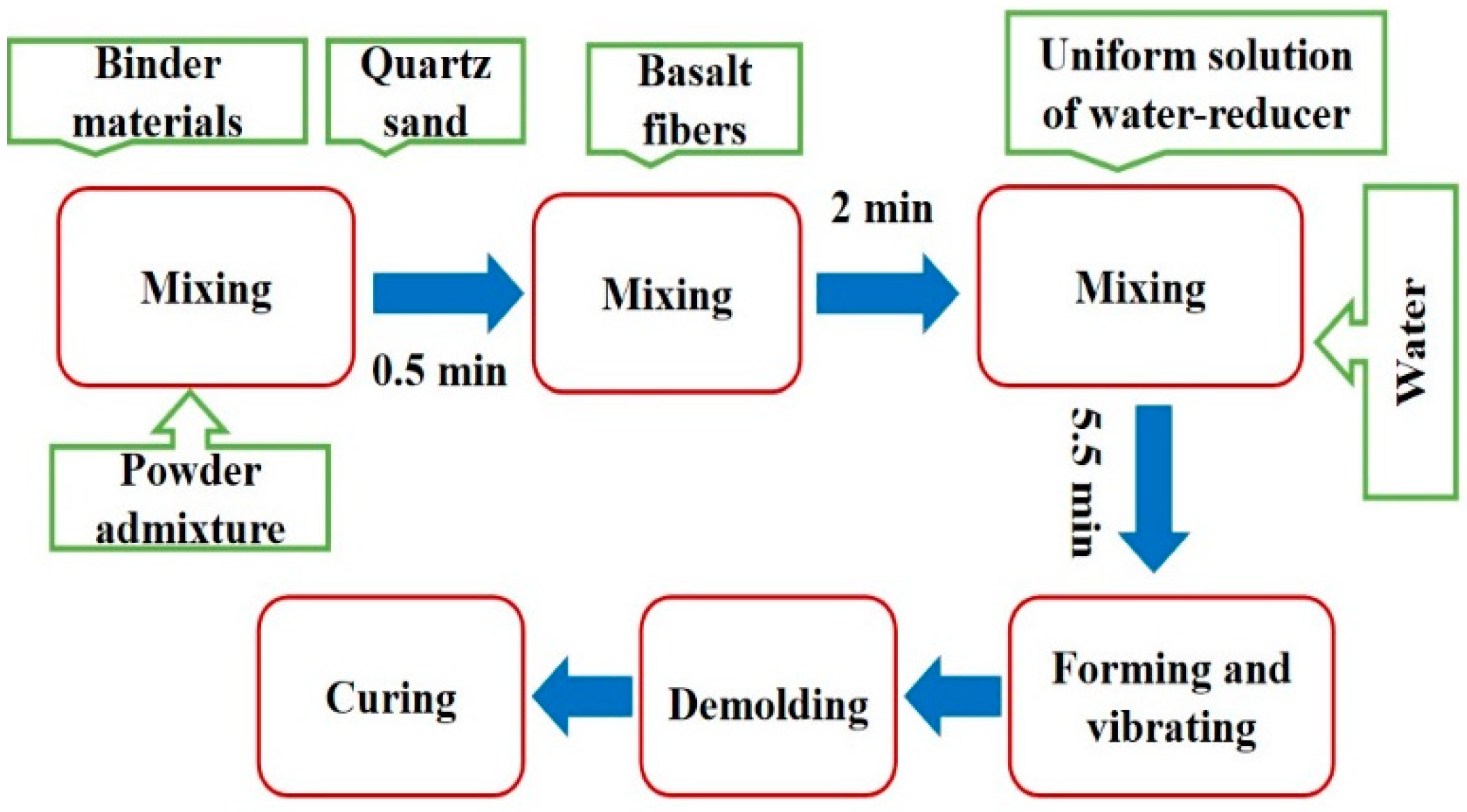

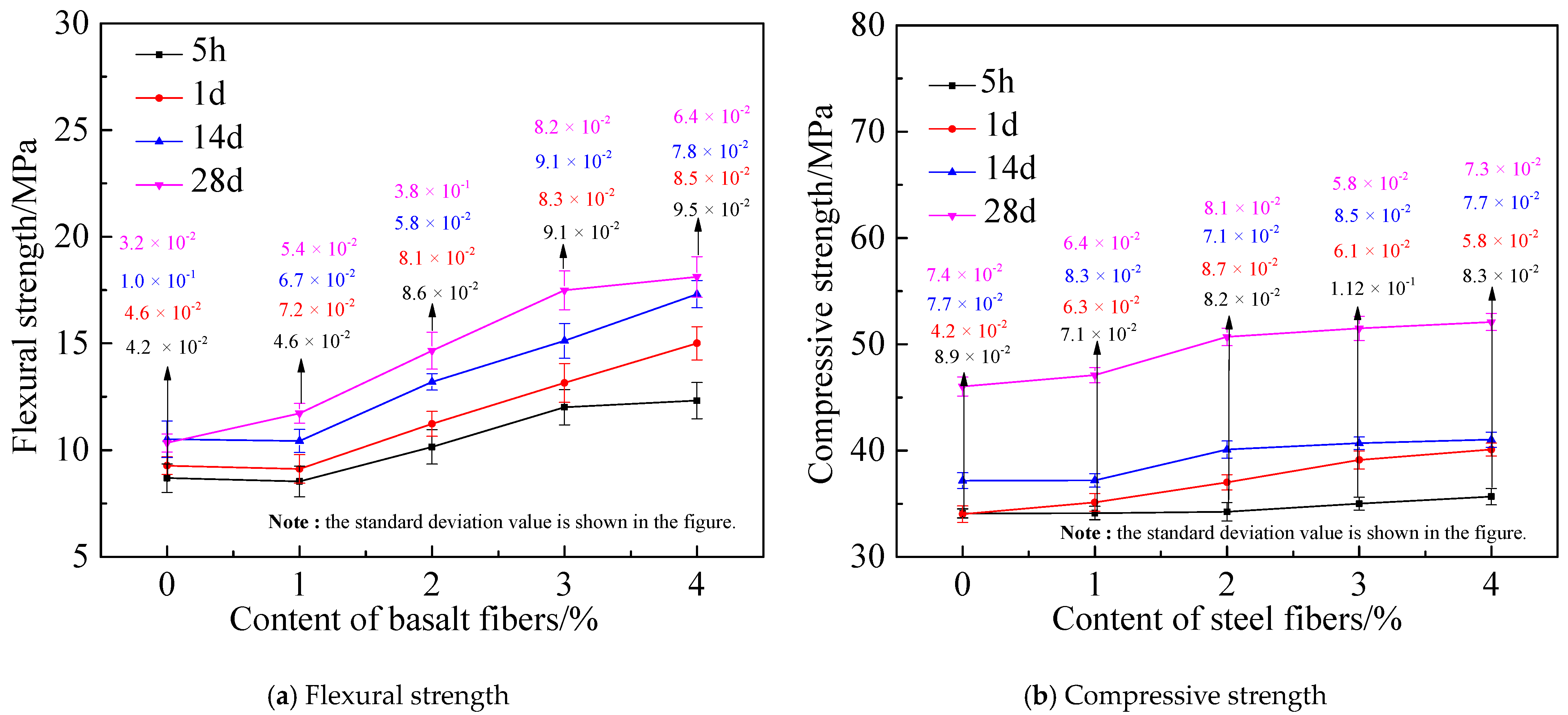
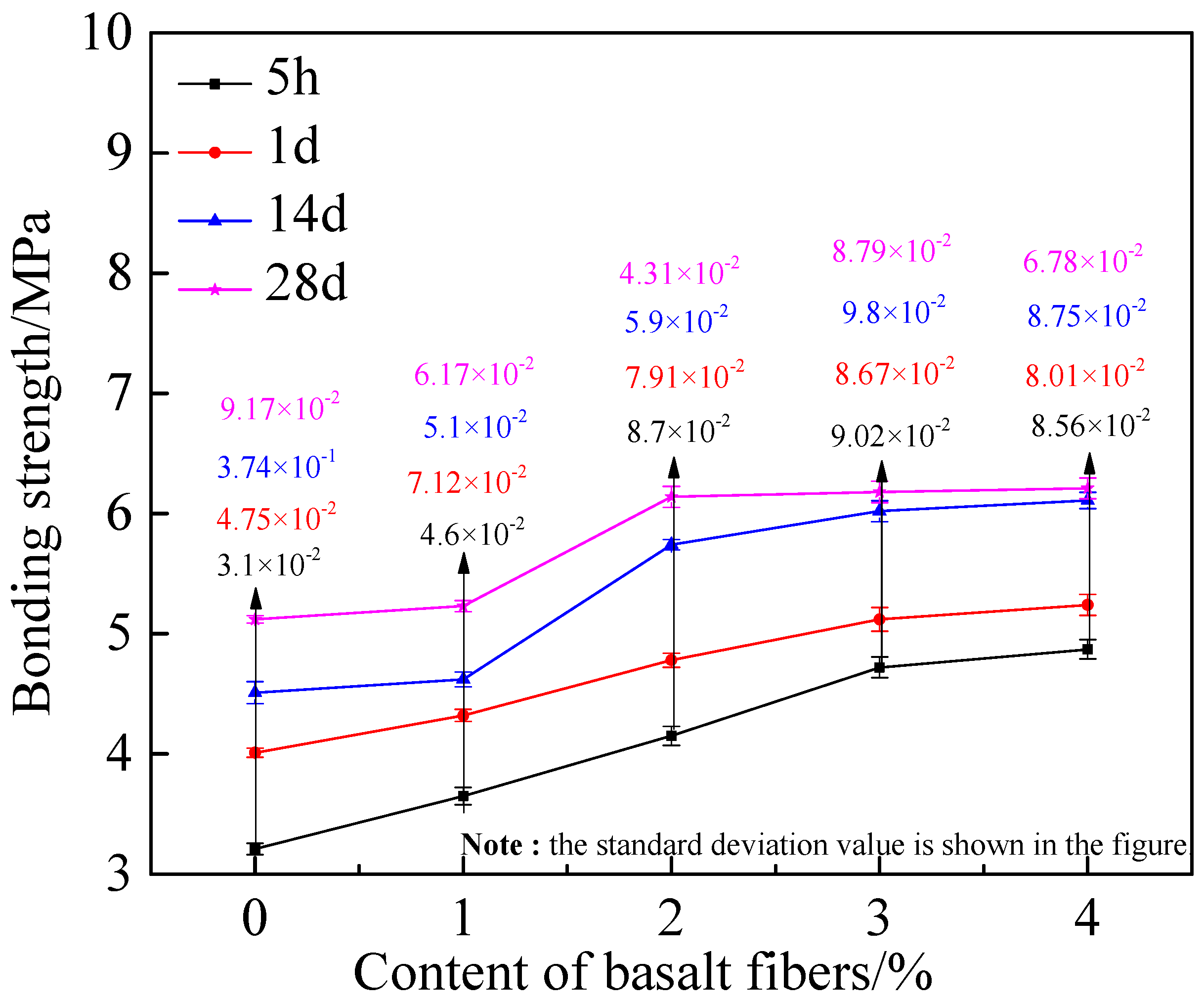
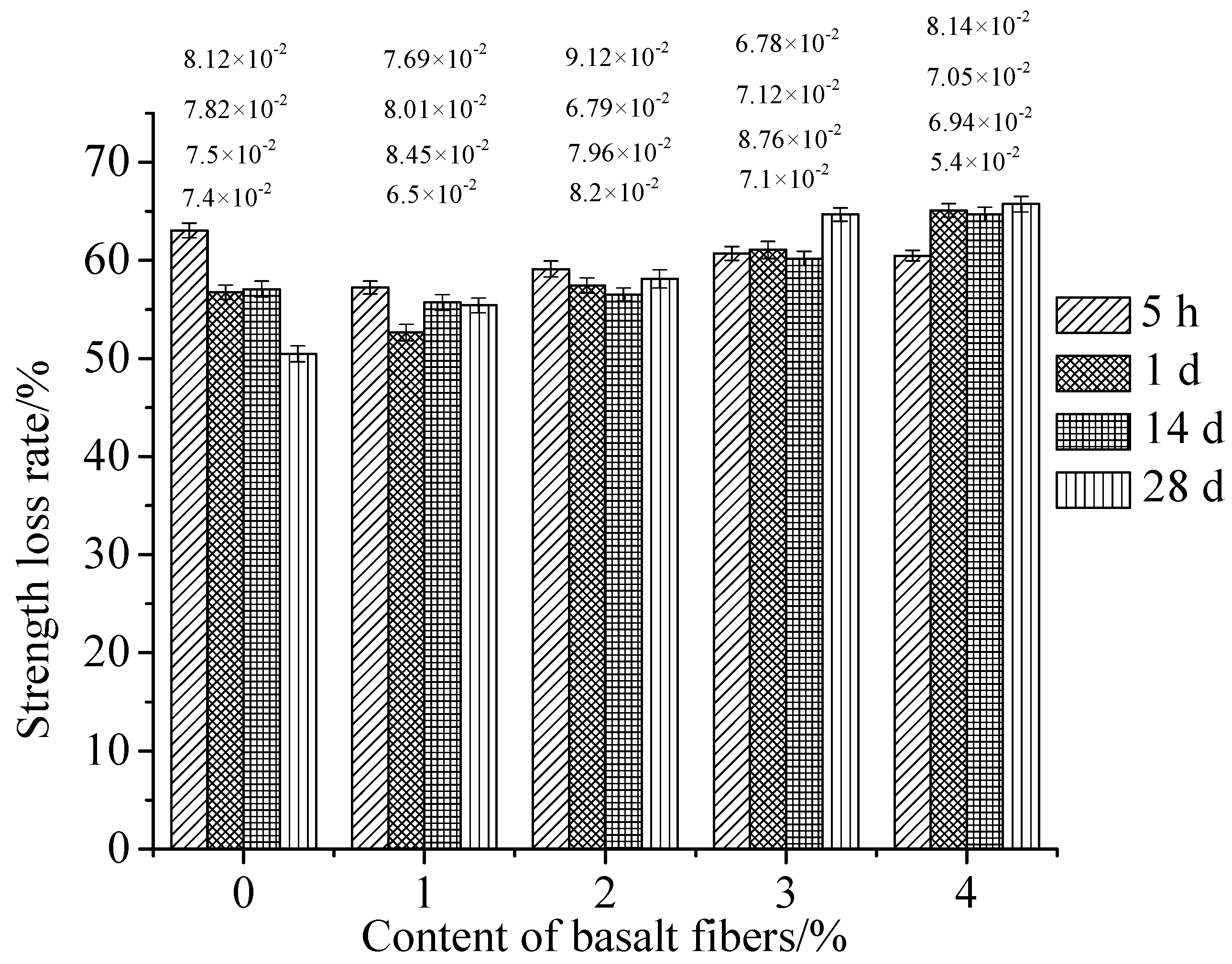

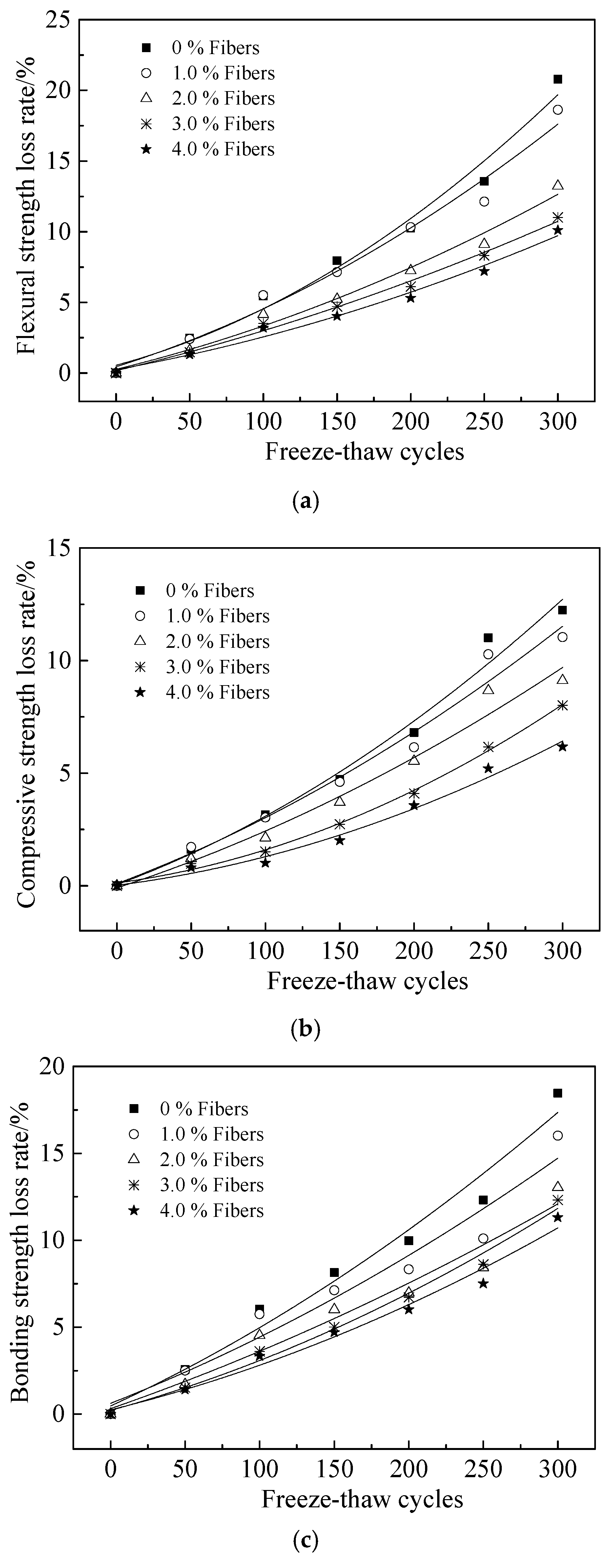


| Types | Particle Size/μm | ||||||
|---|---|---|---|---|---|---|---|
| 0.3 | 0.6 | 1 | 4 | 8 | 64 | 360 | |
| Cement | 0 | 0.33 | 2.66 | 15.01 | 28.77 | 93.59 | 100 |
| Slag Power | 0.025 | 0.1 | 3.51 | 19.63 | 35.01 | 97.9 | 100 |
| Silica Fume | 31.2 | 58.3 | 82.3 | 100 | 100 | 100 | 100 |
| Types | SiO2 | Al2O3 | Fe2O3 | MgO | CaO | SO3 | TiO2 |
|---|---|---|---|---|---|---|---|
| Cement | 13.95 | 22.46 | 2.67 | 2.92 | 39.39 | 14.34 | 1.66 |
| Slag Power | 34.06 | 14.74 | 0.23 | 9.73 | 35.93 | 0.23 | 3.51 |
| Silica Fume | 90 | 0.2 | 0.6 | 0.2 | 0.4 | 0 | 7.4 |
| Equation | Fibers Content/% | a | b | c | R2 |
|---|---|---|---|---|---|
| 0 | 0.03881 | −4.12 × 10−5 | 0.512 | 0.964 | |
| 1 | 0.01845 | 3.25 × 10−5 | 0.0689 | 0.967 | |
| 2 | 0.01595 | 2.73 × 10−5 | −0.0685 | 0.967 | |
| 3 | 0.00656 | 4.33 × 10−5 | 0.0935 | 0.996 | |
| 4 | 0.0062 | 3.19 × 10−5 | 0.0173 | 0.980 |
| Mechanical Strengths | Equation | Fibers Content/% | a | b | c | R2 |
|---|---|---|---|---|---|---|
| Flexural strength | 0 | 0.0281 | 1.19 × 10−4 | 0.554 | 0.974 | |
| 1 | 0.0329 | 8.10 × 10−5 | 0.449 | 0.970 | ||
| 2 | 0.0255 | 5.28 × 10−5 | 0.267 | 0.978 | ||
| 3 | 0.0248 | 3.47 × 10−5 | 0.170 | 0.990 | ||
| 4 | 0.0189 | 4.23 × 10−5 | 0.247 | 0.980 | ||
| Compressive strength | 0 | 0.0245 | 5.92 × 10−5 | 0.0519 | 0.977 | |
| 1 | 0.0249 | 4.39 × 10−5 | 0.0931 | 0.967 | ||
| 2 | 0.0216 | 3.69 × 10−5 | −0.0926 | 0.967 | ||
| 3 | 0.00887 | 5.85 × 10−5 | 0.126 | 0.996 | ||
| 4 | 0.00839 | 4.32 × 10−5 | 0.0234 | 0.980 | ||
| Bonding strength | 0 | 0.0395 | 5.60 × 10−5 | 0.468 | 0.964 | |
| 1 | 0.0336 | 4.46 × 10−5 | 0.622 | 0.930 | ||
| 2 | 0.0298 | 3.14 × 10−5 | 0.317 | 0.944 | ||
| 3 | 0.0237 | 5.02 × 10−5 | 0.215 | 0.985 | ||
| 4 | 0.0211 | 4.61 × 10−5 | 0.247 | 0.972 |
| Equation | NaCl Freeze-Thaw Cycles | a | b | c | R2 |
|---|---|---|---|---|---|
| 0 | −0.164 | 0.0214 | 0.497 | 0.994 | |
| 100 | −0.202 | 0.0186 | 0.853 | 0.954 | |
| 200 | −0.109 | 0.00571 | 1.005 | 0.993 | |
| 300 | −0.218 | 0.0186 | 1.319 | 0.989 |
| Mechanical Strengths | Equation | NaCl Freeze-Thaw Cycles | a | b | c | R2 |
|---|---|---|---|---|---|---|
| Flexural strength | 0 | −0.344 | 0.0874 | −0.338 | 0.860 | |
| 100 | −1.523 | 0.0871 | 8.777 | 0.989 | ||
| 200 | −2.773 | 0.127 | 16.129 | 0.999 | ||
| 300 | −5.586 | 0.543 | 22.807 | 0.985 | ||
| Compressive strength | 0 | −0.297 | 0.0511 | 0.486 | 0.741 | |
| 100 | −1.342 | 0.129 | 6.412 | 0.974 | ||
| 200 | −1.699 | 0.114 | 11.127 | 0.937 | ||
| 300 | −2.304 | 0.0893 | 17.477 | 0.940 | ||
| Bonding strength | 0 | −0.240 | 0.0232 | 0.722 | 0.987 | |
| 100 | −1.342 | 0.129 | 6.412 | 0.974 | ||
| 200 | −3.242 | 0.400 | 12.898 | 0.888 | ||
| 300 | −2.31571 | 0.0614 | 20.227 | 0.989 |
Publisher’s Note: MDPI stays neutral with regard to jurisdictional claims in published maps and institutional affiliations. |
© 2021 by the authors. Licensee MDPI, Basel, Switzerland. This article is an open access article distributed under the terms and conditions of the Creative Commons Attribution (CC BY) license (https://creativecommons.org/licenses/by/4.0/).
Share and Cite
Huang, G.; Wang, H.; Shi, F. Coupling Effect of Salt Freeze-Thaw Cycles and Carbonation on the Mechanical Performance of Quick Hardening Sulphoaluminate Cement-Based Reactive Powder Concrete with Basalt Fibers. Coatings 2021, 11, 1142. https://doi.org/10.3390/coatings11091142
Huang G, Wang H, Shi F. Coupling Effect of Salt Freeze-Thaw Cycles and Carbonation on the Mechanical Performance of Quick Hardening Sulphoaluminate Cement-Based Reactive Powder Concrete with Basalt Fibers. Coatings. 2021; 11(9):1142. https://doi.org/10.3390/coatings11091142
Chicago/Turabian StyleHuang, Guoping, Hui Wang, and Feiting Shi. 2021. "Coupling Effect of Salt Freeze-Thaw Cycles and Carbonation on the Mechanical Performance of Quick Hardening Sulphoaluminate Cement-Based Reactive Powder Concrete with Basalt Fibers" Coatings 11, no. 9: 1142. https://doi.org/10.3390/coatings11091142
APA StyleHuang, G., Wang, H., & Shi, F. (2021). Coupling Effect of Salt Freeze-Thaw Cycles and Carbonation on the Mechanical Performance of Quick Hardening Sulphoaluminate Cement-Based Reactive Powder Concrete with Basalt Fibers. Coatings, 11(9), 1142. https://doi.org/10.3390/coatings11091142







